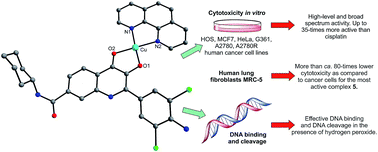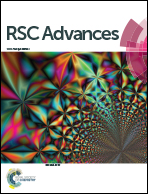Copper(ii) quinolinonato-7-carboxamido complexes as potent antitumor agents with broad spectra and selective effects†
Abstract
A series of five copper(II) mixed-ligand complexes with the composition [Cu(quix)(phen)]NO3·yH2O (1 to 5), where Hquix stands for 2-(4-amino-3,5-dichlorophenyl)-3-hydroxy-4(1H)-quinolinone-7-carboxamides with different N-substitutions: Hqui1 = N-propyl (1), Hqui2 = N-isobutyl (2), Hqui3 = N-cyclohexyl (3), Hqui4 = N-benzyl (4), and Hqui5 = N-p-xylyl (5); phen = 1,10-phenanthroline and y = 0 or 1, were synthesized, characterized and screened for in vitro antitumor activity on a panel of six human cancer cell lines, including osteosarcoma (HOS), breast adenocarcinoma (MCF7), malignant melanoma (G361), cervix carcinoma (HeLa), ovarian carcinoma (A2780) and cisplatin-resistant ovarian carcinoma (A2780R). All the complexes, except for limitedly soluble complex 4, showed very potent cytotoxicity (IC50 ≈ 1–7 μM); the best IC50 value was found for complex 5 against A2780, with IC50 = 0.6(1) μM. Moreover, complex 5 was found to be non-toxic up to 50 μM against non-malignant lung fibroblast cells (MRC-5); therefore, showing a promising selectivity index [IC50(MRC-5)/IC50(A2780)] that was higher than 80. The complexes were also shown to bind to calf thymus DNA, interact with physiological levels of L-cysteine and act as chemical nucleases. It was additionally suggested that the species responsible for the biological activities of the prepared complexes were the [Cu(qui)(phen)]+ cations, or similar cationic species containing the {Cu(phen)} residue. The results clearly demonstrated that targeted structural optimization of the quinolinonato ligand in this class of complexes leads to compounds with high-level and broad-spectrum anticancer activity along with significantly increased selectivity.


 Please wait while we load your content...
Please wait while we load your content...